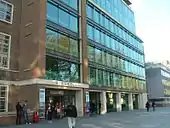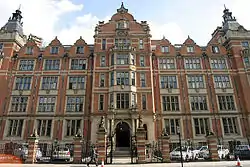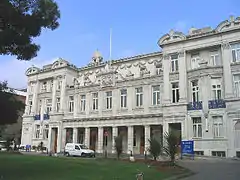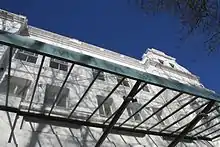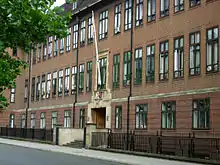Member institutions of the University of London
Member institutions of the University of London are colleges and universities that are members of the federal University of London.
The institutions that make up the university of London have been referred to by a number of different terms historically. From federation in 1900 until the passing of the University of London Act 1994 they were formally "schools of the university" or (until 1978) "colleges incorporated into the university",[1] from 1994 until the passing of the University of London Act 2018 they were "colleges",[2] and from 2018 they have been "member institutions". A member institution is defined in the 2018 act as "an educational, academic or research institution which is a constituent member of the University and has for the time being — (a) the status of a college under the statutes; or (b) the status of a university".[3] This had the effect of allowing institutions to change their status from colleges to universities in their own right while still remaining part of the University of London.[4]
From 2003 onwards some colleges received their own degree-awarding powers.[5] [6] However, these were held in abeyance until 2008, when a number of colleges began to award their own degrees.[7]
Member institutions
The member institutions of the University of London are currently divided as follows, in alphabetical order:
Colleges
- Birkbeck, University of London (BBK) [entered in 1920]
- City, University of London (CIT) [entered in 2016]
- Courtauld Institute of Art [created and admitted in 1932]
- Goldsmiths, University of London (GUL) [entered in 1904]
- Institute of Cancer Research (ICR) [entered in 2003]
- King's College London (KCL) [founding college]
- London Business School (LBS) [created and admitted in 1964]
- The London School of Economics and Political Science (LSE) [entered in 1900]
- London School of Hygiene & Tropical Medicine (LSHTM) [entered in 1924]
- Queen Mary University of London (QMUL) [entered in 1915]
- Royal Academy of Music (RAM) [entered in 2003]
- Royal Central School of Speech and Drama (RCSSD) [entered in 2005]
- Royal Holloway, University of London (RHUL) [entered in 1900]
- Royal Veterinary College (RVC) [entered in 1915]
- St George's, University of London (SGUL) [affiliated in the 19th century]
- School of Oriental and African Studies (SOAS) [created and entered in 1916]
- University College London (UCL) [founding college]
Former Colleges
- Heythrop College, University of London (HEY) [entered in 1971, dissolved in 2018]
- Imperial College London (Imperial) [entered in 1908, left the University of London in 2007]
References
- "Historical Introduction". University of London: the Historical Record (1836-1926). University of London Press. 1926 – via british-history.ac.uk.
- "University of London Act 1994". legislation.gov.uk. Retrieved 8 February 2020.
- "University of London Act 2018". legislation.gov.uk. Retrieved 8 February 2020.
- "UCL statement on University of London Act 2018". UCL. 11 March 2019. Retrieved 8 February 2020.
- Rebecca Smithers and Donald MacLeod (9 December 2005). "College vote brings break-up of university a step nearer". The Guardian.
- Polly Curtis (27 September 2005). "College granted degree-awarding powers". The Guardian.
- "London trio to award their own degrees". Times Higher Education. 23 February 2007.
